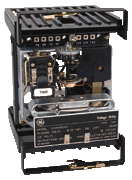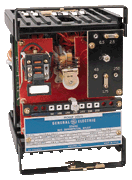MVAA
Auxiliary Relays
The MVAA is a low burden auxiliary relay, which is used to provide multiple contact requirements for protection schemes. The MVAA auxiliary relay is compact in design is mechanically stable. It is user-friendly to operate and can be used to provide multiple contact requirements using a wide voltage range.
Three reset versions suitable for a wide voltage range
Suitable for a wide voltage range, the MVAA comes in manual, self and electrical reset versions. Its compact design and positive action are enhanced with a high degree of mechanical stability.
MVAA
Auxiliary Relays
The MVAA is a low burden auxiliary relay, which is used to provide multiple contact requirements for protection schemes. The MVAA auxiliary relay is compact in design is mechanically stable. It is user-friendly to operate and can be used to provide multiple contact requirements using a wide voltage range.
Three reset versions suitable for a wide voltage range
Suitable for a wide voltage range, the MVAA comes in manual, self and electrical reset versions. Its compact design and positive action are enhanced with a high degree of mechanical stability.
Recommended Products & services
MCAA
Auxiliary Relays
The MCAA relays are current operated attracted armature units of compact design with a positive action and a high degree of mechanical stability. The MCAA is used for connecting in series with tripping relays or circuit breaker trip coils to monitor the presence of current on an ‘all or nothing’ basis. MCAA relays provide output contacts and operation indicator for circuit breaker control, remote and local alarms and event recording.
MCAA
Auxiliary Relays
The MCAA relays are current operated attracted armature units of compact design with a positive action and a high degree of mechanical stability. The MCAA is used for connecting in series with tripping relays or circuit breaker trip coils to monitor the presence of current on an ‘all or nothing’ basis. MCAA relays provide output contacts and operation indicator for circuit breaker control, remote and local alarms and event recording.
Recommended Products & services
SAM Static Timing Relay
Manufacturing for this product has been discontinued. As an alternative, please refer to the MVTT14, MVTT15 and PRiMA relays.
SAM Static Timing Relay
Manufacturing for this product has been discontinued. As an alternative, please refer to the MVTT14, MVTT15 and PRiMA relays.
Recommended Products & services
JBC/JBCG/JBCV Phase and Ground Overcurrent Relay
Manufacturing for this product has been discontinued.
JBC/JBCG/JBCV Phase and Ground Overcurrent Relay
Manufacturing for this product has been discontinued.
Recommended Products & services
IJS Synchronism Check Relay
Manufacturing for this product has been discontinued. As an alternative, please refer to the 889 relay.
IJS Synchronism Check Relay
Manufacturing for this product has been discontinued. As an alternative, please refer to the 889 relay.
Recommended Products & services
IFV Time Delay Voltage Relay
Manufacturing for this product has been discontinued. As an alternative, please refer to the P94V relays.
IFV Time Delay Voltage Relay
Manufacturing for this product has been discontinued. As an alternative, please refer to the P94V relays.
Recommended Products & services
GGP Power Directional Relays
The usual application of the GGP relay is to prevent motoring of a turbine-driven generator. Its intended purpose is to protect turbines not equipped with integral protective means if its steam supply is lost or reduced. Under such a condition the generator will take power from the bus and run light as a synchronous motor, driving the turbine at normal speed. With insufficient or no steam present in the turbine, the blades may be damaged by overheating as developed by windage. Under normal operating conditions, such heat is dissipated into the steam.
GGP Power Directional Relays
The usual application of the GGP relay is to prevent motoring of a turbine-driven generator. Its intended purpose is to protect turbines not equipped with integral protective means if its steam supply is lost or reduced. Under such a condition the generator will take power from the bus and run light as a synchronous motor, driving the turbine at normal speed. With insufficient or no steam present in the turbine, the blades may be damaged by overheating as developed by windage. Under normal operating conditions, such heat is dissipated into the steam.
Recommended Products & services
IAV Time Delay Voltage Relay
The Type IAV relays are single phase induction disk relays designed to respond, with time delay, to either an increasing or a decreasing voltage, or both. Some models are frequency compensated, and some include an instantaneous unit (hinged armature type). Most models listed in the Selection Guide include a target seal-in unit on all contacts.
IAV Time Delay Voltage Relay
The Type IAV relays are single phase induction disk relays designed to respond, with time delay, to either an increasing or a decreasing voltage, or both. Some models are frequency compensated, and some include an instantaneous unit (hinged armature type). Most models listed in the Selection Guide include a target seal-in unit on all contacts.
Recommended Products & services
SBD Differential Voltage Relay
The Type SBD11B is a single-phase, high-speed differential relay. It is specifically designed to provide bus differential protection, but may also be used for differential protection of shunt reactors. A high impedance, voltage measuring circuit with overcurrent supervision is used for fault detection. The utilization of static circuitry results in very short operating times. Output isolation is obtained with a telephone-relay, and a target seal-in unit is provided. A voltage selecting link allows the relay to operate on 48, 125, or 250 VDC.
SBD Differential Voltage Relay
The Type SBD11B is a single-phase, high-speed differential relay. It is specifically designed to provide bus differential protection, but may also be used for differential protection of shunt reactors. A high impedance, voltage measuring circuit with overcurrent supervision is used for fault detection. The utilization of static circuitry results in very short operating times. Output isolation is obtained with a telephone-relay, and a target seal-in unit is provided. A voltage selecting link allows the relay to operate on 48, 125, or 250 VDC.
Recommended Products & services
PVD Differential Voltage Relay
The Type PVD21 relay is a single-phase, high-speed, high-impedance, voltage-operated relay designed to provide protection in bus differential schemes. The Type PVD21 utilizes the same operating principle (high impedance voltage) as the earlier PVD models, but provides faster operating speeds and higher seismic capabilities. Typical operating speed is 20 ms at 4X pickup. The Type PVD21 is mechanically interchangeable with the earlier PVD21 models, and provides additional output contacts.
PVD Differential Voltage Relay
The Type PVD21 relay is a single-phase, high-speed, high-impedance, voltage-operated relay designed to provide protection in bus differential schemes. The Type PVD21 utilizes the same operating principle (high impedance voltage) as the earlier PVD models, but provides faster operating speeds and higher seismic capabilities. Typical operating speed is 20 ms at 4X pickup. The Type PVD21 is mechanically interchangeable with the earlier PVD21 models, and provides additional output contacts.






